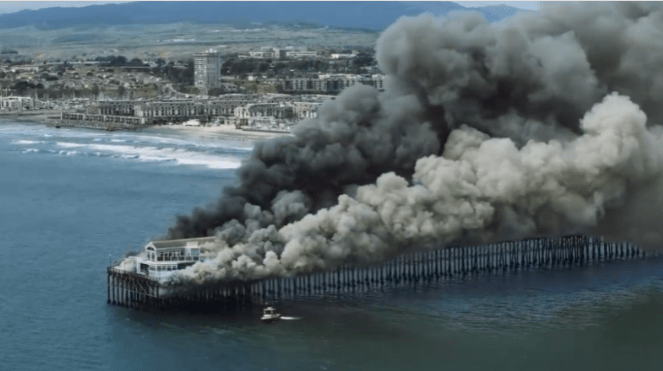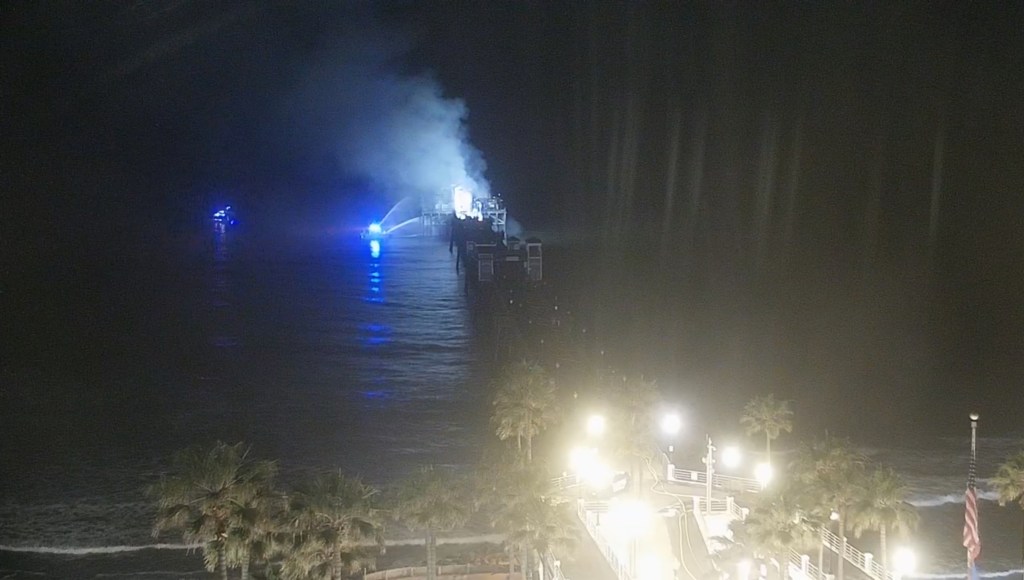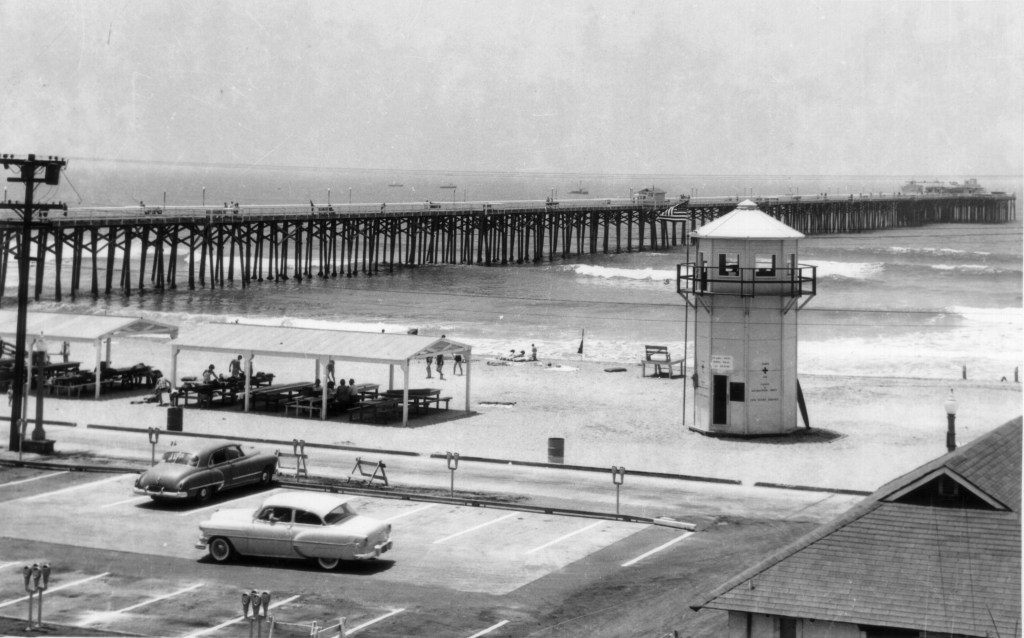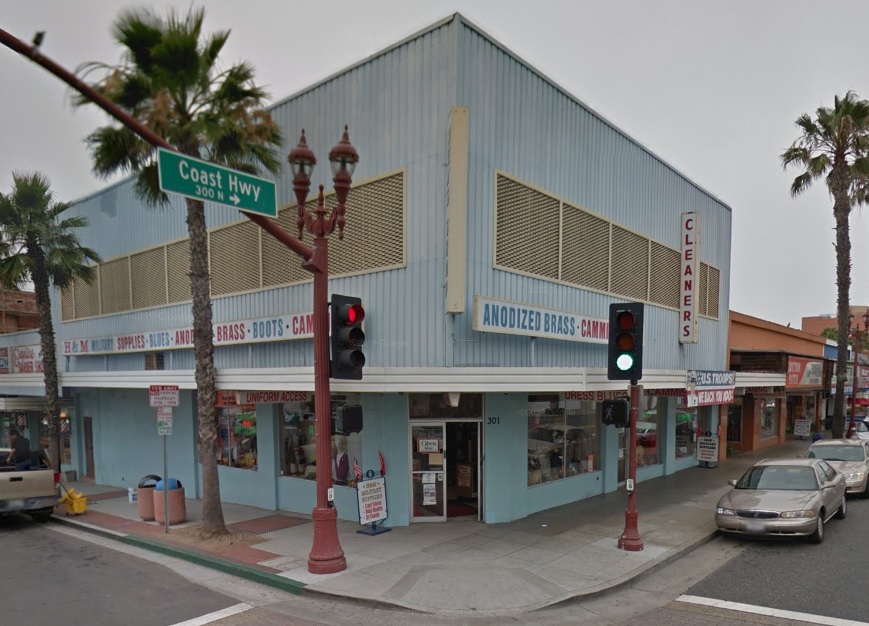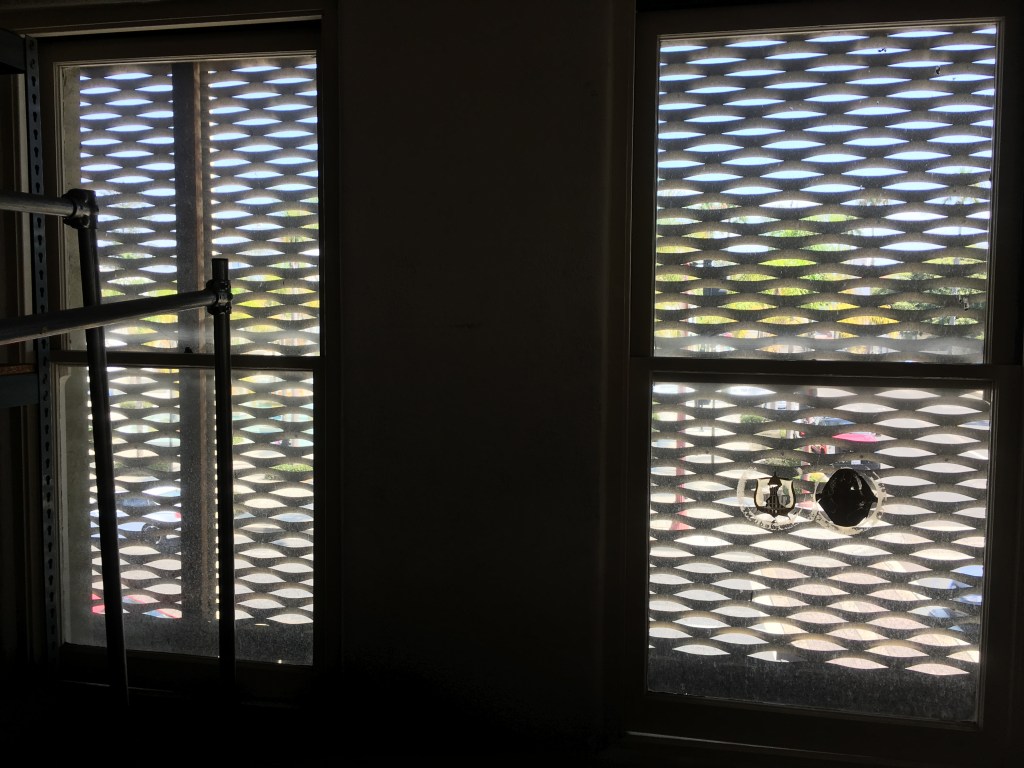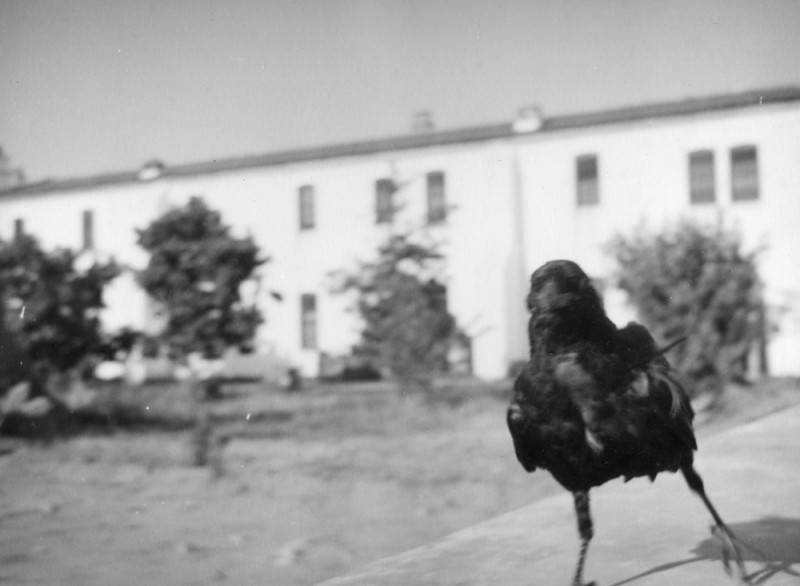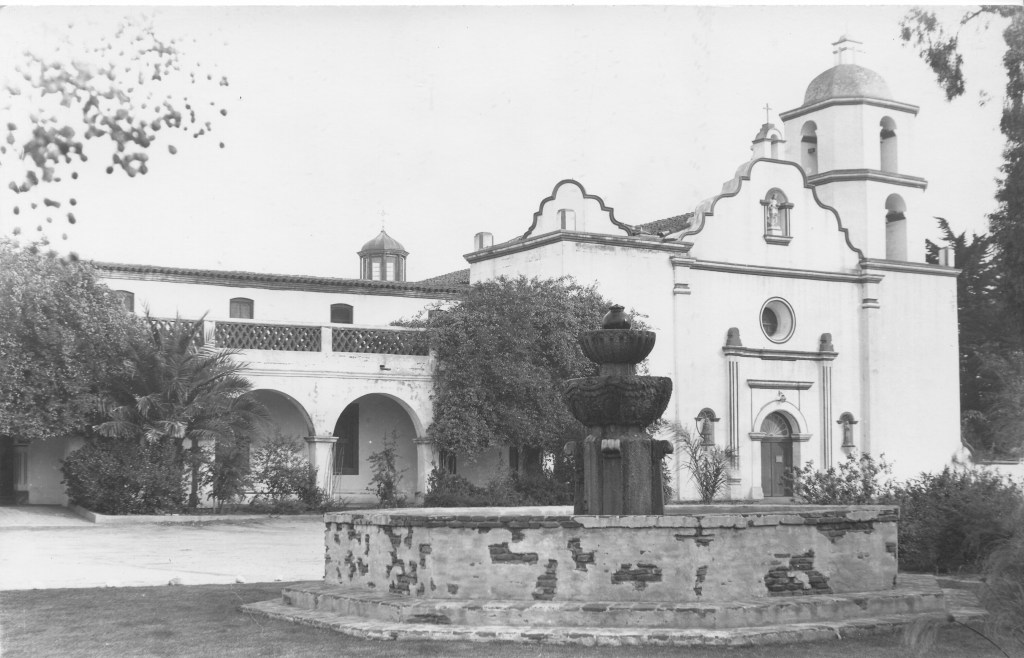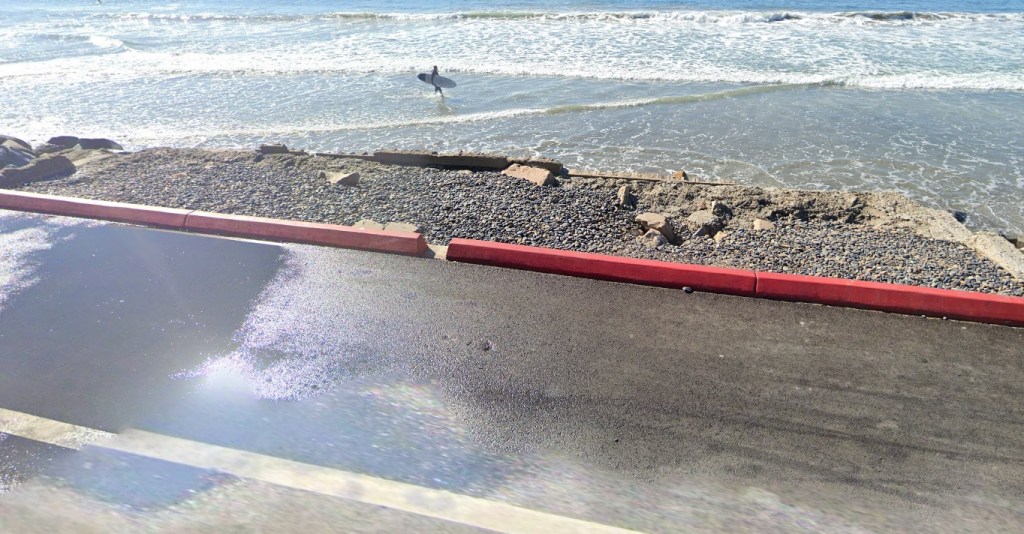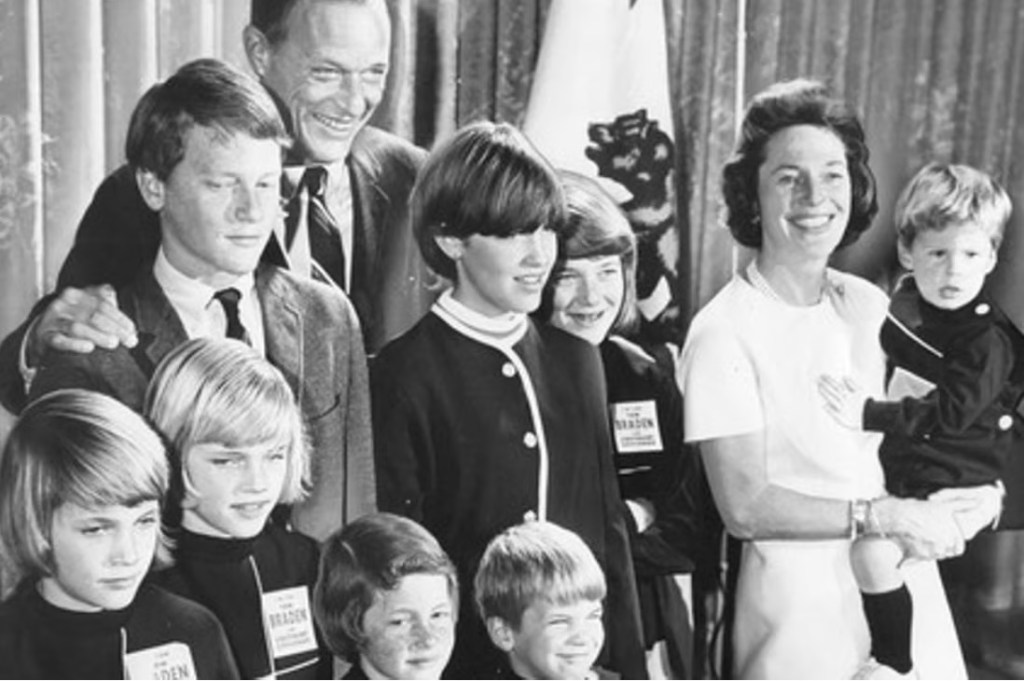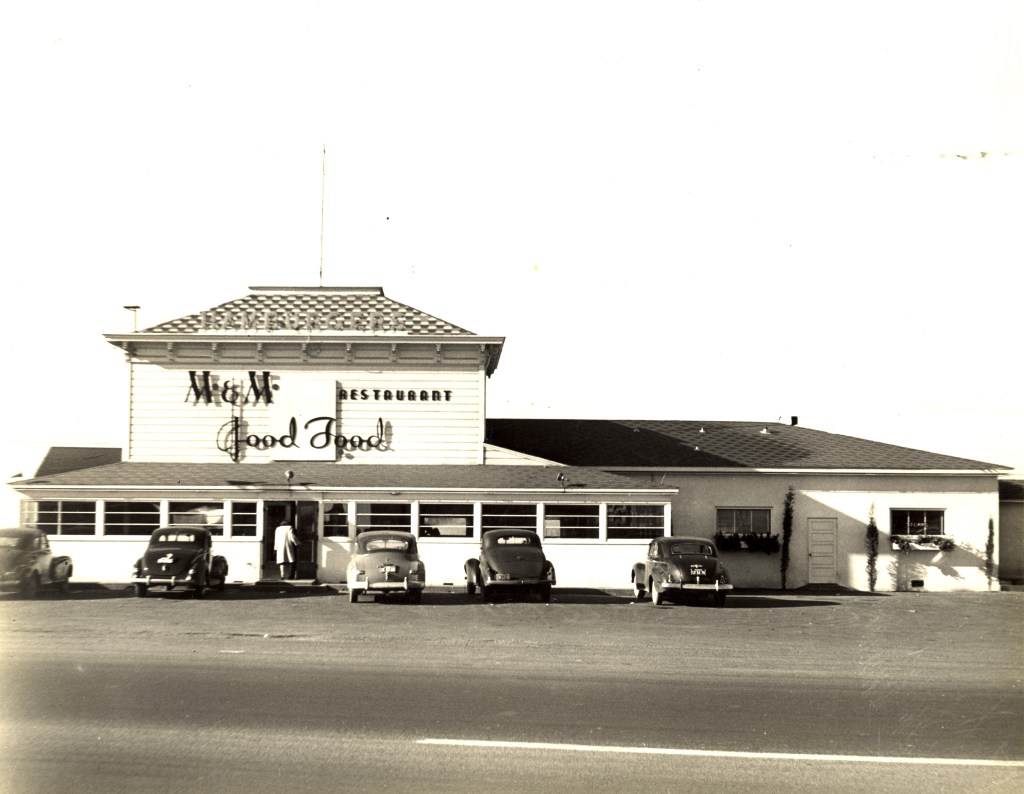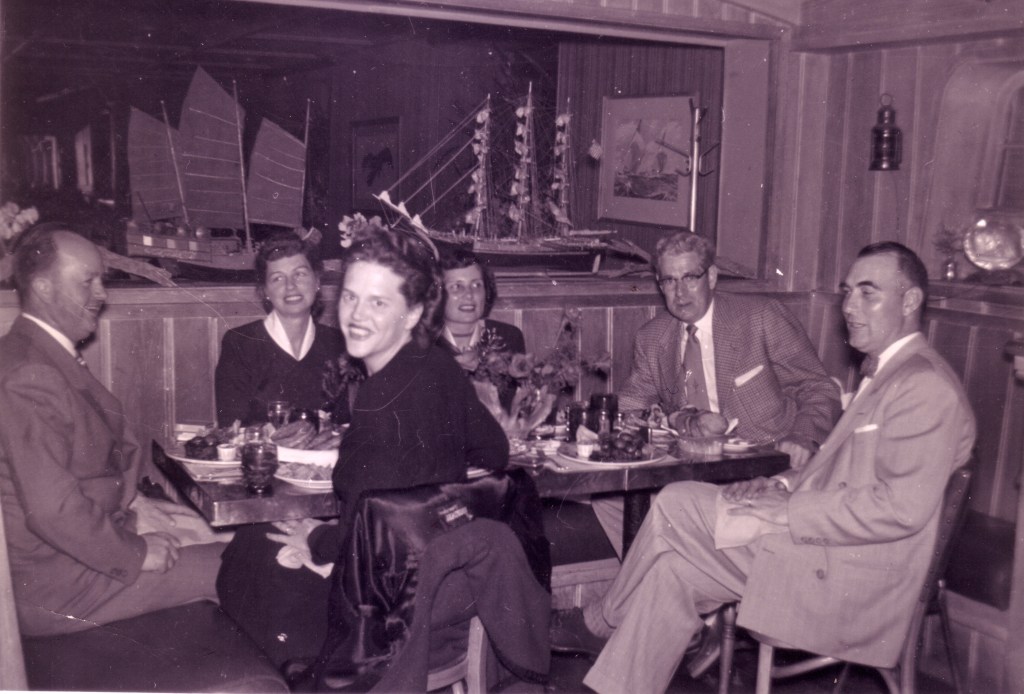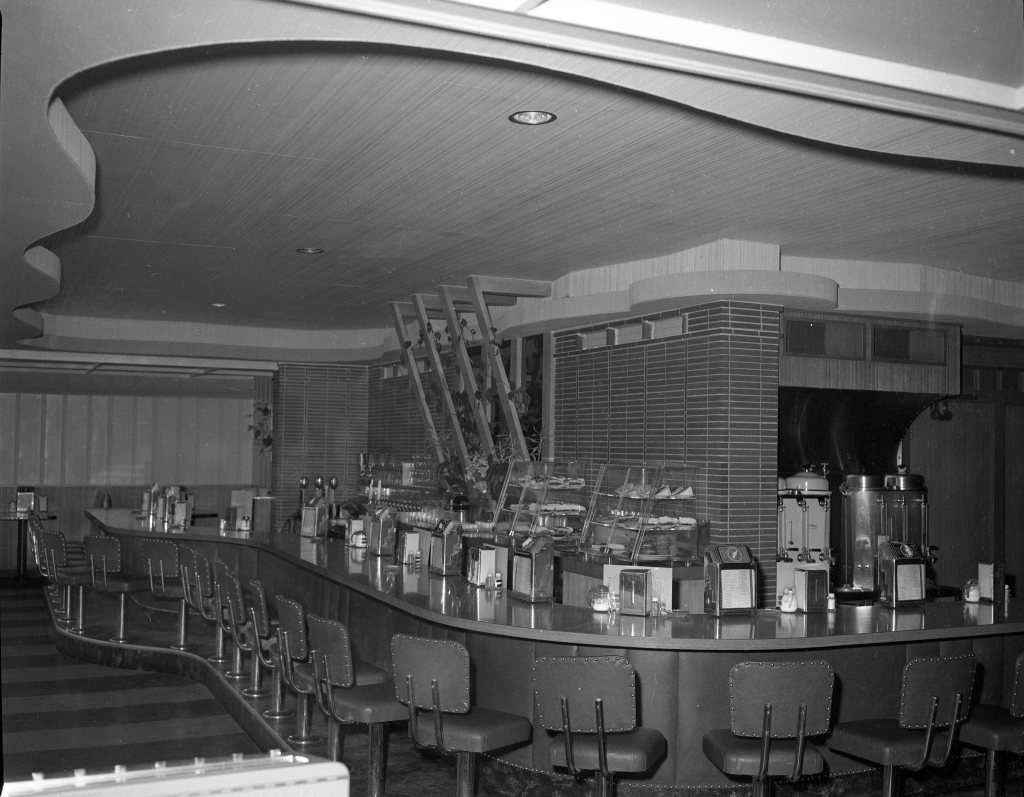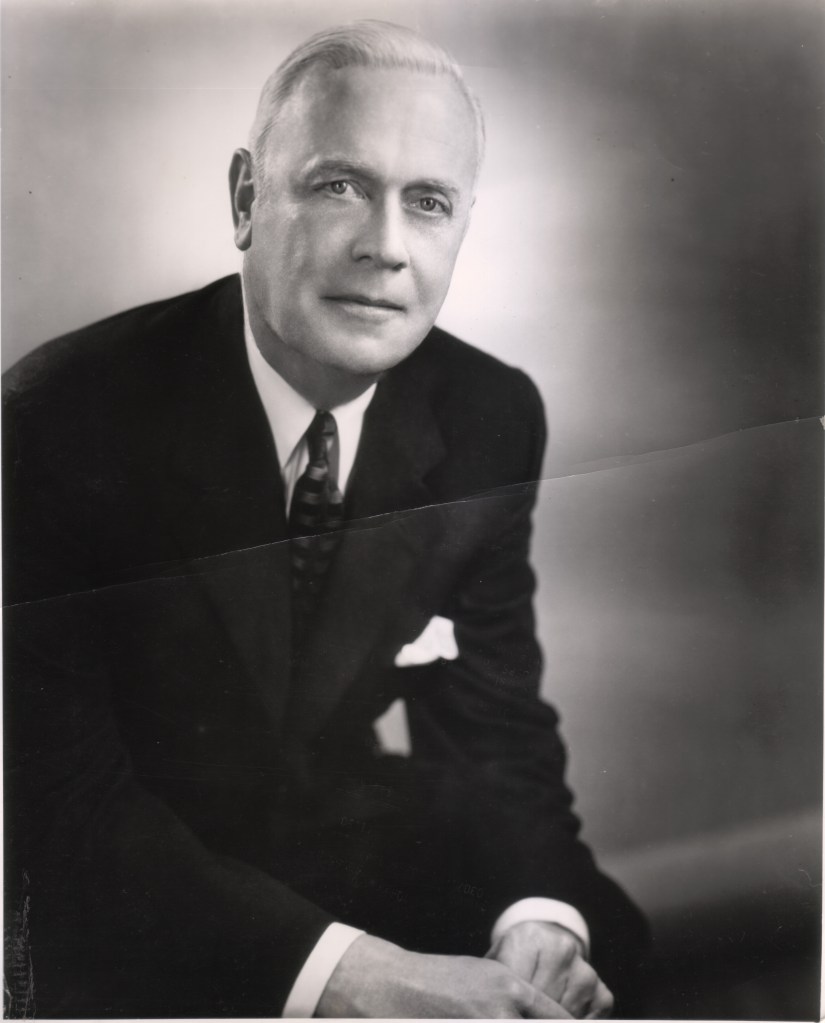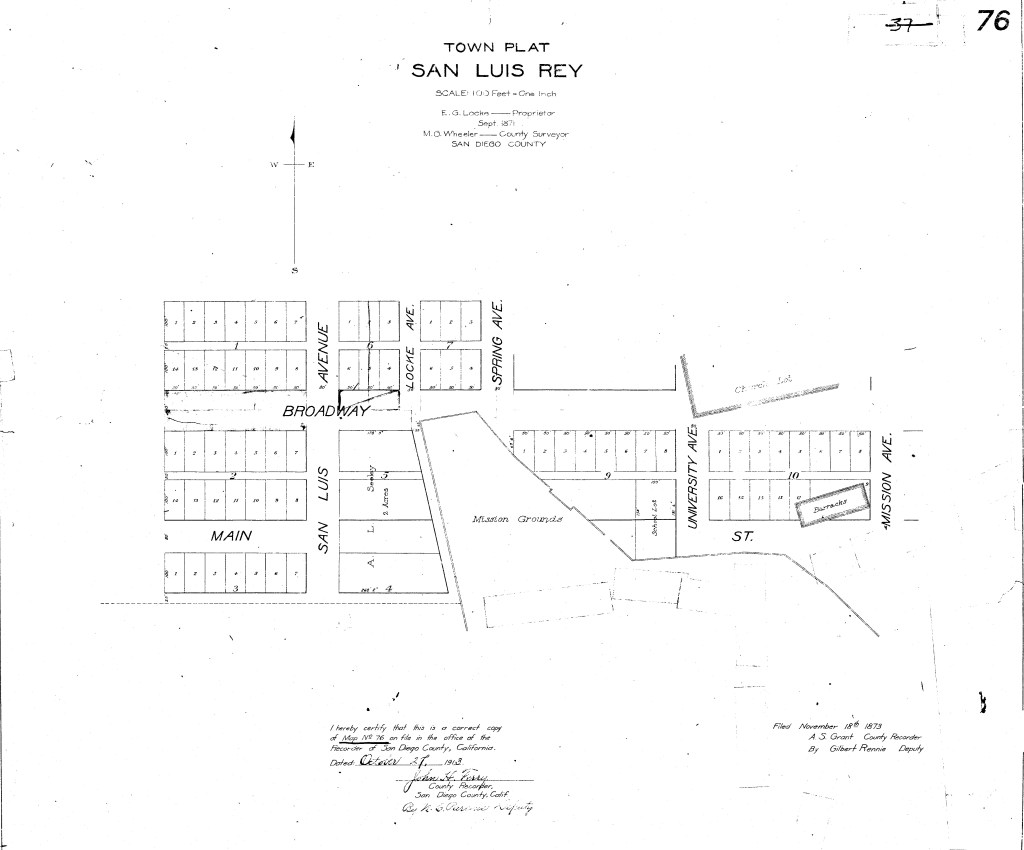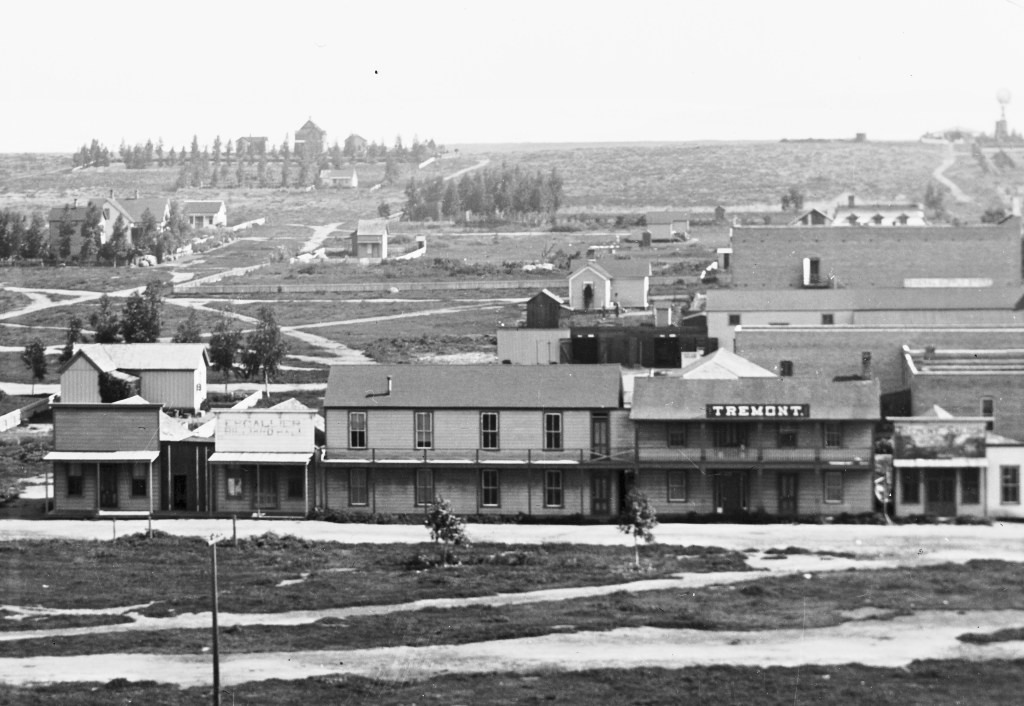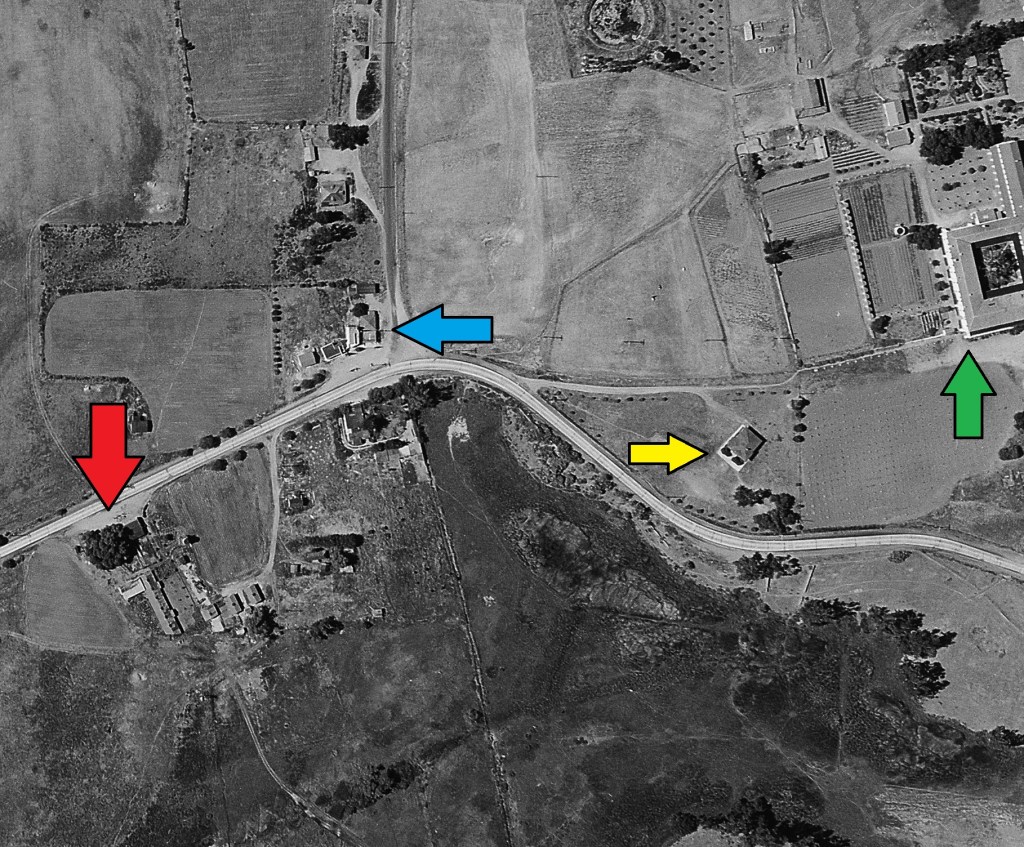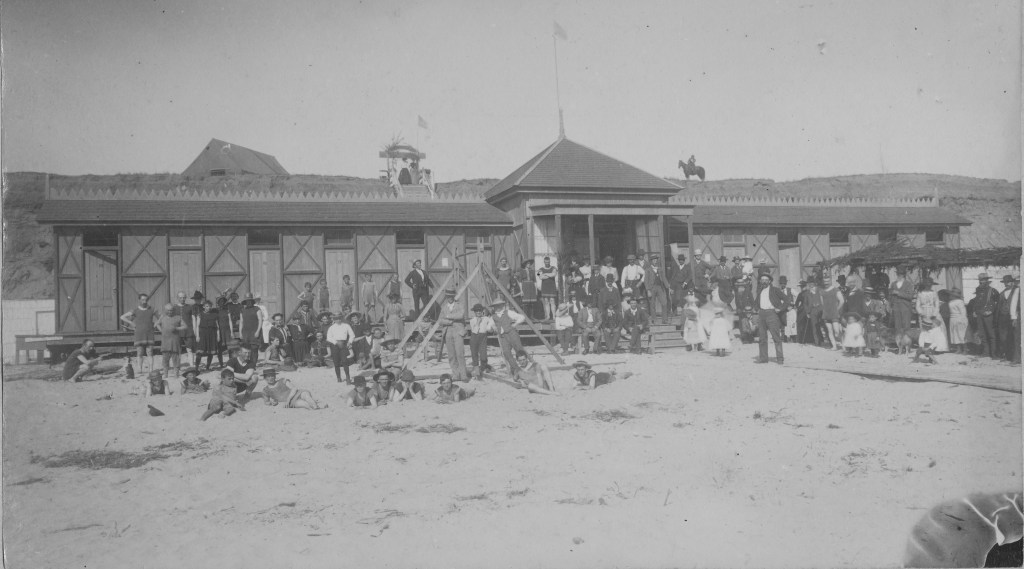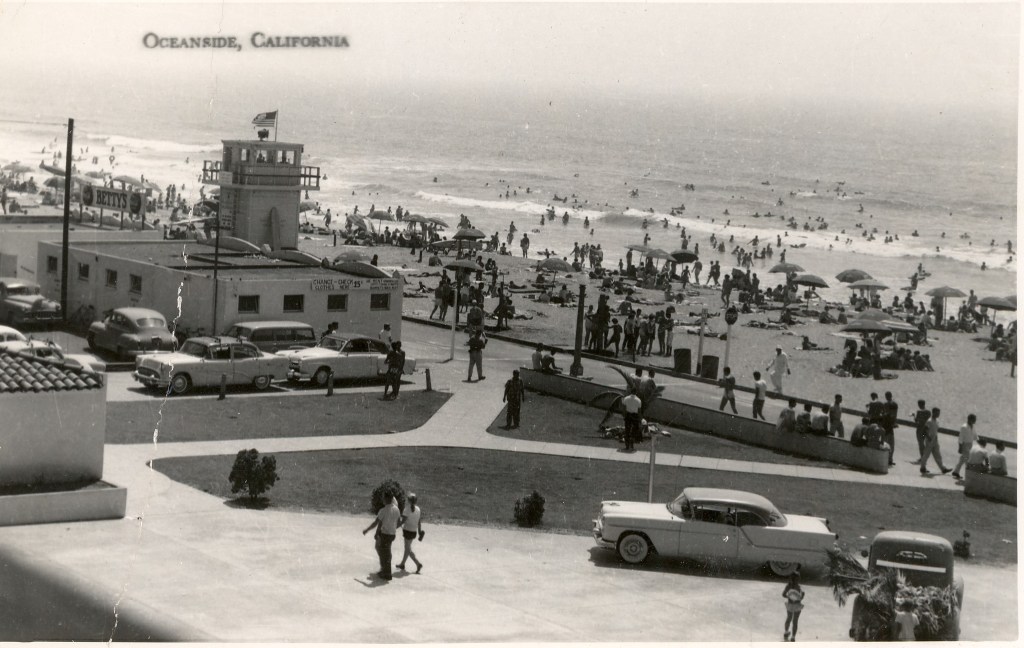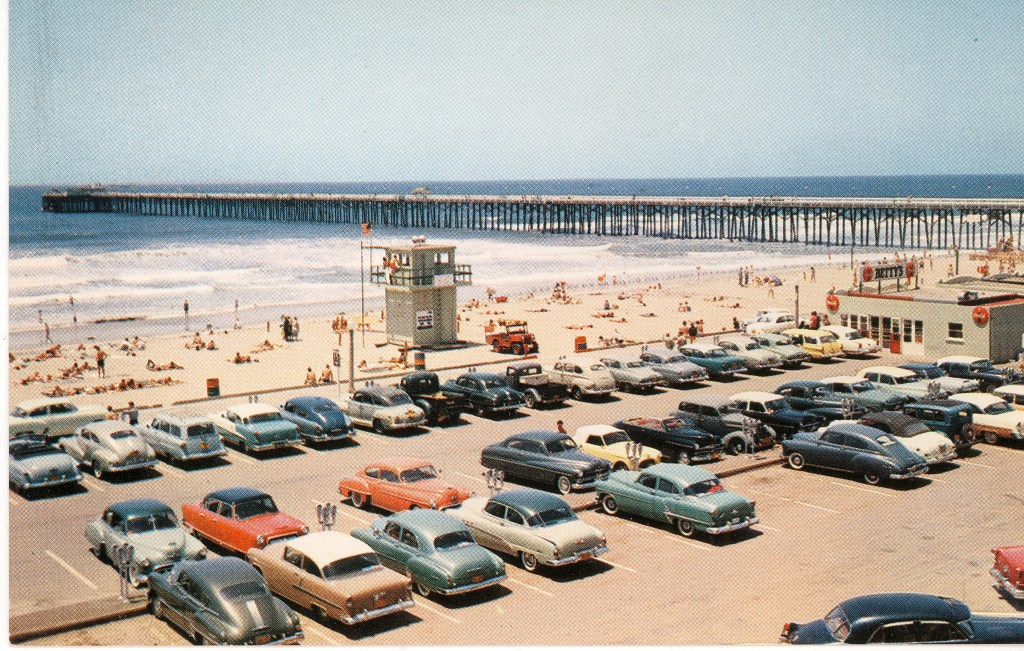A small cottage home near downtown Oceanside, California was once the headquarters of an influential protest movement during the Vietnam War. Celebrities such as Jane Fonda and Elliott Gould made appearances at the house to encourage and show support to protest organizers and their followers.

In June of 1969 an underground organization known as the “Green Machine” affiliated with the Movement for a Democratic Military (MDM) met in a small home near Vista, and encouraged planned demonstrations at both the Camp Pendleton military base and in the City of Oceanside.
The meetings were modest in size, attracting between 30 and 75 persons. The Oceanside Blade Tribune newspaper identified the local movement as an anti-war organization similar to other “coffee house groups across the nation” operating “under the guise of providing entertainment for servicemen while spreading an anti-war and anti-military message.”

The group was headed by Kent Hudson and Pat Sumi, attracting a following of both military and civilians, mainly students.
Kent Leroy Hudson was born in 1944 in Riverside County, California. As a youth he attended Vista High School, graduating in 1962. Hudson was also a Stanford graduate and a Navy Reservist. In 1965, Hudson spoke at the Vista-San Marcos Democratic Club about his experiences in Louisiana and voter registration of Blacks that summer.
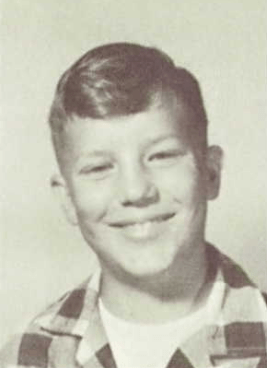
In July 1968, Hudson had joined what the San Luis Obispo Telegram-Tribune called a “16-person troupe” who had organized small campaigns to encourage protests of the draft and oppression. The newspaper described the group as “bone-tired” and that their two-week campaign had exhausted their funds with no great result.
Hudson would find the following he was seeking one year later when he relocated his efforts to the Vista and Oceanside area in San Diego County. He first applied for a permit to operate a coffee house in Oceanside but was met with resistance from the city council. The group settled on a small house at 2133 North Santa Fe Avenue and converted the garage into a meeting space.
Oceanside Police Sergeant John Key described the location: “The house in Vista was surrounded by slit trenches that had been dug all the way around the house. There had been concertina wire strung on barricades that could have been pulled across the access to the house. It was, for all intents and purposes, fortified.”
Sumi and Hudson held modest gatherings, looking for support. Folksinger Barbara Dane offered it in the way of a performance and held a concert at the Armed Services Center in Oceanside.

Volunteer workers and staff at the center were “surprised” by the performance as they expected folk, not protests songs. It was reported that the largely military audience joined Dane in singing anti-war songs and shouting “Join the ASU”, short for the American Servicemen’s Union. Hudson himself reported that one person in the crowd stood up and shouted, “Shoot the Lifers!”
After her performance, group members held a party at the house in Vista and a movement was born. Meetings were announced through “handbills” which were passed out to Marines by Green Machine supporters on Camp Pendleton. Then members picked up the Marines, and others interested in the meetings, on Saturday nights at various pickup points.
The Oceanside Blade Tribune described a typical meeting: “There the audience gets a soft-sell anti-war take from Pat Sumi, an accomplished speaker. They are also served free coffee and beans, and often treated to folk-singing of anti-war and anti-military songs. Recent meetings have featured a Black Panther leader from San Francisco, and nationally known folk singer Phil Ochs, an avowed pacifist. The meeting featuring the Black Panther leader included “liberation” films and speeches threatening black insurrection.”
In perhaps to alienate white readers from the group, the newspaper described the attendees as predominantly Black: “Approximately two-thirds of the audience of about 65 was black, most were Marines, but there were also two black students from Oceanside attending.”
A list of “demands” was published and distributed by the group, which read in part:
- We demand the right to collective bargaining
- Extend all human and constitutional rights to military men and women
- Stop all military censorship and intimidations
- Abolish all mental and physical cruelty in military brigs
- We demand the abolition of present court-martial and nonjudicial punishment systems
- We demand wages equal to the minimum federal wage
- We demand the abolition of the class structure of the military
- End all racism, everywhere
- Free all political prisoners
- Stop all glorification of war now prevalent in all branches of the military
- Abolish the draft and all involuntary enlistment
- Pull out of Vietnam now

The immediate goals of the Green Machine were as follows:
- Disturbances involving police were to be escalated by the military personnel
- Military personnel were to wear black armbands while on liberty in civilian clothes
- To have mass meetings in the Oceanside beach area on December 15, 1969
- To have another mass meeting at Buddy Todd Park on March 15, 1970
- To start a newspaper called the Attitude Check
- Marines were to create problems aboard the base at Camp Pendleton
While similar groups were organizing all over the country, the Green Machine’s presence was an uneasy and unfamiliar one for Oceanside. For over two decades the city had embraced the military and their families since the base was established in 1942 during World War II. The population included many former military personnel who chose to make their home in Oceanside after their stint (long or short) in the Marines or Navy. Many residents and business owners were in angst over the anti-war messages the group espoused, because even if they themselves were not in favor of the war, they wanted to support the military.
It was clear that Hudson just wasn’t against the war, but against the Marine Corps as a military institution when he wrote the following statements:
“No clear-thinking man joins the Marine Corps, there are to (sic) many better alternatives.”
“I have yet to meet the marine who joined to serve his country. He certainly exists, but in a tiny majority.”
“The Force Reconnaissance trainees I have met are mostly acid heads.”
The Green Machine sponsored a bus trip to Los Angeles where members could meet with Black Panthers, and the group continued on to San Francisco to participate in a march. The trip was paid for by Green Machine “allies.”
The MDM held its first rally in Buddy Todd Park in September of 1969, where it first attracted the attention of local officials and police, and the FBI was kept advised of its activities. They began publishing an underground newspaper called “Attitude Check” which was offered to Marines in downtown Oceanside.
Theresa Cerda, a local resident recalled in a 1999 interview that she got involved in the group after attending a “love-in” in Cardiff. Kent Hudson spoke and asked if anyone was interested in “organizing the G.I.’s to resist the war” to meet with him afterwards.
A 17-year-old high school student at that time, Cerda explained that the movement was funded by “rich lawyers” who “were willing to fund us to be their mouthpiece, but they backed us with money and legal. They were more the fundraiser people, the glamour, the upper echelon, we were the grunts, and we went out and did all the work.”
Hudson and group members would take vans from their house in Vista and travel to downtown Oceanside and walk the streets passing out leaflets. Teresa remembered that they were met with both resistance and acceptance. “On Hill Street [or] Coast Highway — that was very scary because we had a mix of people. I remember several times when some of the Marines would get really upset and take stacks of stuff away from me and burn them. There were times when other Marines would gather around me and protect me and say, ‘this is freedom of speech and I want to hear what she has to say’. It was usually the Black Marines, the African American Marines that would protect me. And then soon, it started snowballing and then after that we had a good mix.”

Organizers planned a beach rally in Oceanside in November of 1969, an event that set many in Oceanside on edge. City officials attempted to block the organized march, appeals were filed, and protestors vowed to march with or without a permit. The Oceanside Blade Tribune urged residents to remain calm with an editorial entitled “Keep Cool Sunday”.
“The courts will decide today whether Sunday’s march and rally in Oceanside will be held with or without the sanction of a parade permit from Oceanside. The constitutional questions of right of free speech and assembly are the heart of the issue – and whether the city’s decision is a political one as charged or merely enforcement of city ordinances.
But the court decision is really secondary to the march for it will happen regardless of the court’s ruling.
March organizers have stated they plan to walk through the city on the sidewalks – rather than parade through the streets – to fulfill the march plans.
Organizers say it is too late to call off the march, and it is too late. Leaflets have been distributed to colleges in Southern California advertising the demonstration.
The spectre of violence, and that possibility is high in the minds of law enforcement officials charged with the responsibility of maintaining law and order Sunday, is a main overriding factor.
There are rumors of marines from Camp Pendleton staging a counterdemonstration to protest the anti-war and anti-military philosophies of the marchers.
There is also going to be a relatively large contingent of Black Panthers in the march and recent events involving the organization would indicate no love lost on their part for law officials.
Angela Davis, the communist college professor, is also scheduled to speak and the massive patriotism of the area may likely be sharply prodded by what she may say in her speech.
The potential for violence is high.
But if everyone – marchers, the speakers, the marines, the spectators, and those pro and con – will just cool it Sunday, everything will go off without a hitch.
Although there are always troublemakers in marches of this nature, the main body of the marchers are quit determined to keep things peaceful.
March leaders have informed The Blade-Tribune they intend to do all in their power to keep the peace and are bringing 200 monitors in to patrol the march.
There will be little sense in letting passions and tempers, however justified by philosophy and belief, flare into violence.
The only loser will be the city of Oceanside.
The march will only be a memory after Sunday, and it would be much better as a peaceful memory.”
The day of the march the Blade-Tribune minimized and mocked the organizers and persons expected to speak.
“There is a beautiful lineup of characters for the day:
– Former military officers who wouldn’t follow orders;
– Black Panthers who have preached hate and violence in this country since their organization was founded;
– A Communist teacher;
– Leftwing “peace-at-any-price” speakers;
– Unhappy military types who can’t take discipline and order;
– A full parade of fuzzy-thinking, fuzzy-looking creeps.
There is nothing good; you can say about this march, unless you espouse the thinking of those who support it.
So stay home today. There are very few area residents who will be supporting this march. Don’t be counted among them. Don’t help the Communist cause.”
In contrast the conservative stance the local newspaper took, John Richardson, a nephew of Oceanside Mayor Howard T. Richardson, was an avid supporter of the march and saw “the protest movement in this country as a means of solving problems.” An Oceanside High School math teacher, he encouraged his students to take part or at least an interest in the MDM’s message.

The Blade Tribune reported a list Richardson’s views and remarks: “He views the reaction of Oceanside Police and town officials to both [the] march and the Green Machine as “in conflict with the Bill of Rights.”
“I get just as upset when I read of the reaction of most people to the Green Machine as I did when I heard President Agnew’s attack on the press,” said Richardson. “My own personal opinion is that there are many needs in this country which are just beginning to surface.”
The article continued saying “Richardson explained the presence of Black Panthers at Green Machine meetings by saying black servicemen aboard Camp Pendleton had “expressed a desire to find out what the Panthers is all about.” Richardson, who has attended “five or six” meetings of the Green Machine said however he had never been present at a meeting of that group when a Black Panther spoke. Yet, he criticized an eye-witness account of a Green Machine meeting at which Panthers did speak, published in the Blade Tribune.
“He explained that he had been at other meetings where the Panthers spoke and said he felt in sympathy with the reporter who attended the Green Machine meeting only because he knew it “must have been the first time he had heard the Panthers speak.”
“It can be scary,” said Richardson, “especially the first time someone is exposed to it. After that however you realize that they are speaking from their hearts and from the heart of the black ghetto,” said Richardson. “Their language is the language of the ghetto, and the ghetto is not a happy place.”
“We need change, and we need it fast,” he said. “This need for change…for good change in the American political systems is why I support the movement in general and why I support the Green Machine in Oceanside. The movement is where the demand for change if being generated. Fear of the movement and fear of change is the situation Oceanside is confronted with.” He cited Oceanside’s “over-reaction” to the Green Machine as a case in point.

The Movement for a Democratic Military, along with Rev. William R. Coates of La Jolla, coordinated the planned march and rally which was sponsored by the Citizens Mobilization Committee (CMC), which secured a court order for the march permit when the city council refused to grant it.
The march began at Recreation Park, just east of Brooks Streets and made its way west to downtown. It was reported that 250 active-duty servicemen participated and that they represented “almost 40 per cent of ‘snuffies’ in the Southland who sympathize with the MDM.” Snuffies were Privates or low-ranking military members.
The vast majority of the marchers came from outside of Oceanside from other organizations and included the Peace Action Council of Los Angeles, the Socialist Workers Party of Los Angeles, the SDS of Los Angeles and San Diego, the Black Panther Party of Los Angeles and were joined by the Young Socialist Alliance, Student Mobilization Committee, the Clergy and Laymen Concerned and Medical Committee for Human Rights.
The Oceanside Blade Tribune described the scene: “Marchers carrying hundreds of signs, most calling for an end to the war in Vietnam. Many of the signs also urged support for various anti-war and anti-military groups. Most of the marchers were young, in their teens and twenties, but several middle-aged persons and a few elderly persons marched. The vast majority of the marchers wore hippie or mod clothes, but some of the marchers were dressed in business suits and fashionable clothing.

“Marchers chanted, “One, two, three, four, we won’t fight your fascist war,” and “Peace, Now!” and “Two, four, six, eight, let’s destroy this fascist state,” and “Power to the People.”
“A march cheerleader atop a bus leading the parade kept up a continual banter of slogans, many in support of the Black Panthers. There were few Black Panthers present, despite a scheduled mass turnout.
“There were very few spectators along the mile-long march route until it reached the downtown business area. Most of the spectators were obviously against the march, but a few joined the march as it progressed downtown.
“A crowd of about 200 spectators, mostly Camp Pendleton marines, was gathered along Hill Street between Mission and Third Street. Some of the spectators jeered and booed the marchers.
“Just before the march reached the Beach Stadium, a brief scuffle broke out when an angry marine attempted to charge a marcher who was carrying a Viet Cong flag. His companions and police subdued him.”
A vehicle parked along the demonstration route greeted marchers with the slogan, “Better Dead Than Red” painted on its side. As the march continued on Hill Street to Third Street (Coast Highway to Pier View Way) a vocal gathering at the USO challenged the anti-war group with their own signs and slogans.
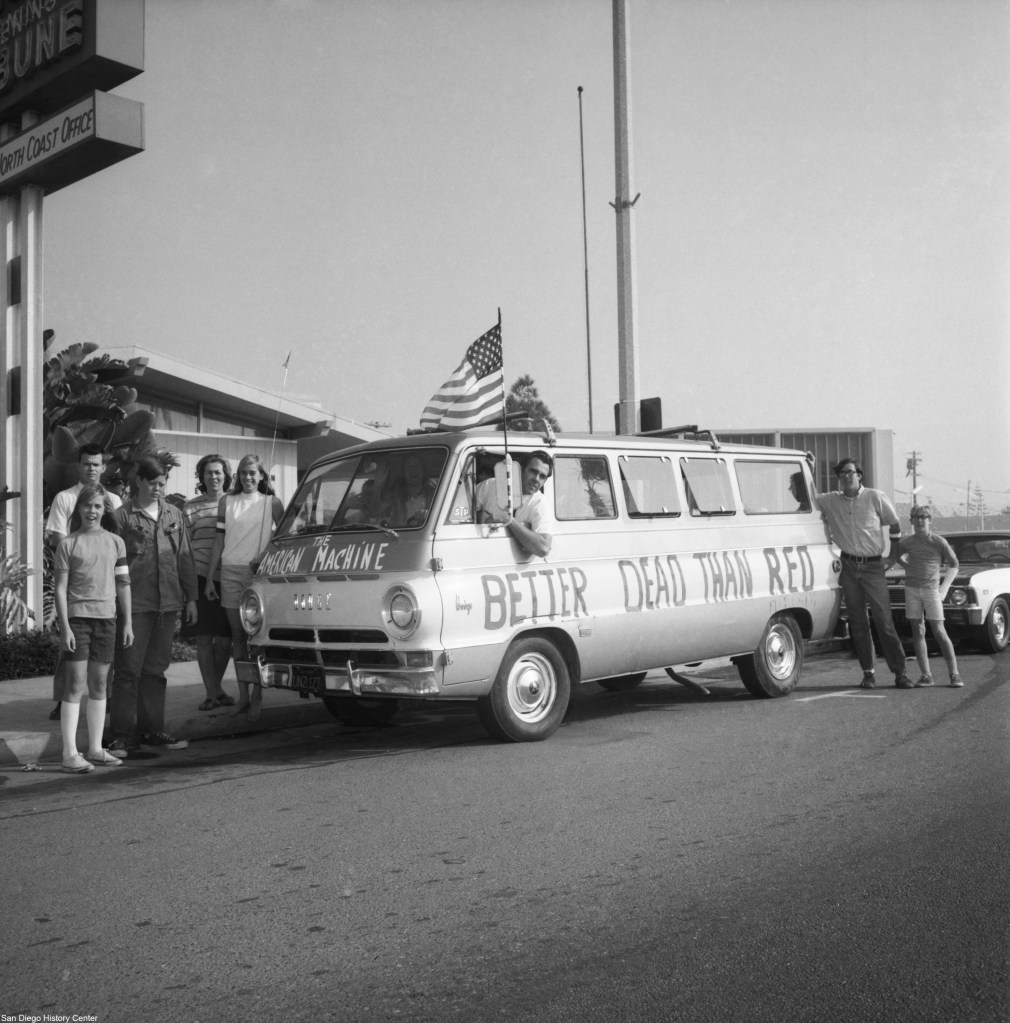
The march culminated at Oceanside’s beach amphitheater where the keynote speaker was Angela Davis. The local newspaper described her as tall and lanky and added she “could have passed for a high fashion model.”
It had been reported that an “armed pro-war marine” was “perched somewhere in the crowd with a rifle, ready to gun down Angela Davis, the Marxist UCLA assistant philosophy professor.” A request was made for members of the MDM to form a “human cordon” around Davis. The Blade Tribune reported that “at first, only black marines showed up but several white marines showed up when a call was issued, ‘Let’s see some whites up here too.’”

A group of 10 to 12 men accompanied Angela Davis and her sister Fanta to the stage at the Oceanside bandshell. It was noted that while surrounded by her protectors, Davis was “barely visible” while she spoke.
She began her speech by calling “Richard M. Nixon, our non-president, a hypocrite who is a killer, a pig and a murderer.” She called for an end to “genocide” and other “imperialist action” against the Vietnamese people and the black community, specifically the Black Panthers.”

“There are people who will be shocked about My Lai but they will do nothing more than sit back and say how outrageous it is. They don’t realize that My Lai is no exception. It is the essence of U.S. government policy in Vietnam, just like the Chicago and Los Angeles raids are the essence of policy toward the Black Panther Party.
“The Green Beret is trained to murder Vietnamese. In Los Angeles, the police pigs have a special squad rained to murder Panthers – SWATS, the Special Weapons and Tactical Squad who came to present the warrants to our 11 black sisters and brothers in the Panther office.
“Why are the Black Panthers the target of attack? J. Edgar Hoover said it is because the Panthers pose the greatest threat to national security.
“And we pose the greatest threat to the Nixons, the Reagans, the Yortys, the Kennedys, the defense industry, the ruling class of this country … because they have shown the masses that it is necessary for all oppressed people to unite.”
Davis went on to set the following demands:
– Immediate and unconditional withdrawal of all troops in Vietnam.
– Victory for the National Liberation Front, political speakers for the North Vietnamese.
– Recognition of the South Vietnam Provisional Revolutionary Government, set up for the Paris peace talks, as being the true representatives of the people.
– That the occupying force be withdrawn from the Black Community.
– That all political prisoners, including Panthers Bobby Seale, Huey Newton and Eldridge Cleaver, be freed.
– That the liberation movement be victorious for the oppressed peoples.
Davis was followed by Susan Schnall, a former Navy nurse who was court-martialed for participating in anti-war rallies. Other speakers were Captain Howards Levy, United States Army (Retired) and Don Duncan, an ex-Green Beret.
The protestors and demonstrators were observed by approximately 190 law enforcement officers, representing every agency in San Diego County. No arrests were made although there were skirmishes between Marines and demonstrators and varying factions amongst the gathered groups. Law enforcement “covered every intersection” and “monitored the parade route.”
After the speeches were over, demonstrators and spectators began leaving the beach stadium, but a group of angry Marines remained behind police lines. They eventually “dashed through the stadium and into the streets behind the dispersing demonstrators.”
The Marines, a group estimated at 75 “charged into the main body of demonstrators on Third Street (Pier View Way) near the Santa Fe Railroad tracks” and nearly two dozen people openly fought in the street. Marine PFC Merl Windsor, 18 years of age, suffered a laceration after he was struck in the head by a rock thrown by demonstrators.
Law enforcement separated the two groups which ran east toward Hill Street (Coast Highway) and stood on opposite corners. The Marines waved a large American flag, and “cheered their side of the issue” while the demonstrators hurled “an occasional taunt and threat.” There was no other violence reported.
To restore order, police dispersed the crowds and drew a “line of demarcation down the middle of Third Street, and attempted to keep traffic flowing on Hill Street. By 6:30 p.m. the situation was termed “secure” and by 7 p.m. downtown Oceanside was nearly deserted.
“It’s a tough job when you must provide protection for both sides the peace-marchers and the counter-demonstrators,” Police Chief Ward Ratcliff told the Oceanside Blade Tribune. He added that the rumor of an attempt to assassinate Angela Davis was unsubstantiated. Ratcliff noted that none of the “estimated 3,500 to 4,000 demonstrators were left stranded in town” and that he was “thankful for the community support the police department received.”
“There were times when they [police officers] were challenged and they remained calm. We could have very easily had a serious situation,” Ratcliff said.
Mayor Richardson said the march “Looked like an open sewer running through the streets.”

A few months later, in March of 1970, the Movement for a Democratic Military opened a coffee house in the Eastside neighborhood of Oceanside at 418 San Diego Street. It was reported that Black residents clashed with members of the MDM and that one evening shots were fired but no one was injured.
Just days after the Eastside location was established, and perhaps because of the unexpected confrontations, it was announced that the “Green Machine,” would be headquartered at a small house at 519 South Freeman Street.
Purchased for $19,000, the two-bedroom house was obtained via a “double closing” which is the simultaneous purchase and sale involving three parties: the seller, a middleman and a final buyer. This double closing was likely done in order the conceal the identity of the purchaser(s).
The Oceanside Blade Tribune reported that the “purchase was handled by Strout Realty, who were unaware of the actual buyers of the house. A complicated chain of trustees and secondary brokers which winds back to a Beverly Hills-based broker and a Palo Alto resident purchased the house, telling agents of Strout Realty that the property would be used as ‘rental income.’ [The] actual owner of the house apparently is Paul Robert Moore, of Palo Alto, who purchased the house through the Lawrence Moore trust funds.”
After the house was purchased on South Freeman Street, Cerda recalled meeting celebrities like actress and activist Jane Fonda, her sister Lynn Redgrave, along with actors Donald Southland and Elliott Gould, who provided financial support to the movement. Katherine Cleaver, attorney, Black Panther activist and wife of Eldridge Cleaver provided political clout and legal support. While visiting the MDM headquarters celebrities and those with political status would build up the morale of members by visiting and eating “beans from a pot” with them.
A flyer was distributed that read: “The Green Machine Project and Movement for a Democratic Military invites you to an Open House and MDM Meeting.” It went on to say that “We are going to have political speakers Robert Bryan and others from the Southern California Black Panther Party, and special guest, Miss Jane Fonda.”

A leaflet was distributed in the downtown neighborhood which stated in part: “The Green Machine Project and Movement for a Democratic Military have moved into a staff house and meeting place at 519 S. Freeman. You have probably heard or read a great deal about us in the past few months, much of it negative. We would like to have a chance to counter many of the distortions and outright lies by opening our doors to you. We would be pleased if all our new neighbors would stop by and chat with us to find out what we are really all about. Our doors are usually open from noon until late in the evening every day except Monday.”
On Sunday March 22, Jane Fonda arrived at the small house on Freeman Street, accompanied by three members of the Black Panther Party. She met with approximately 30 guests at the MDM headquarters, stayed about two hours and then departed.
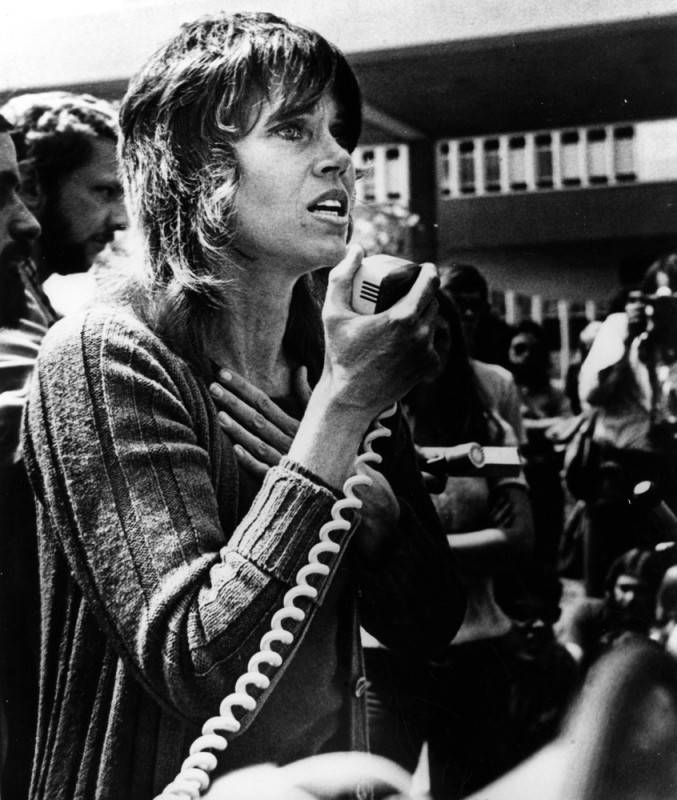
While the invitation passed around seemed welcoming, the house itself was fortified and its occupants armed. Sandbags had been stacked to create a barricade on the interior of the home. Gun ports made of bricks were spaced between the walls of sandbags. The attic contained a bell and a “light warning system.”
Six weeks later, on April 28th, the house and its occupants were fired upon by an unknown gunman in a car. Eleven rounds were fired, one striking and wounding Pvt. Jesse Woodward, Jr., of Support Company, H&S Battalion, Camp Pendleton. Woodward was struck in the shoulder and taken to the Naval Hospital aboard Camp Pendleton. Identified as a “deserter from the Marine Corps” Woodward, age 19, had been absent without leave for over 4 weeks, a base spokesman said.
The Oceanside Police Department were called and dispatched to the residence at 11:55 p.m. Upon their arrival they found “about a dozen rounds of ammunition, probably .45 caliber, had been fired into the front of the house.” Police confiscated eight to nine rifles and shotguns in the possession of the MDM group.
An unidentified woman at the house was shaken, “We’ve known something like [this] might happen for a long time and our first reaction was to hit the floor.” She pointed to a large cut on her knee saying, “this came from crawling through the glass.”
Thomas Hurwitz, one of the organizers of the MDM claimed that the group was unaware that Woodward was a deserter and responded to the shooting advocating for peace: “We are urging those who attend to adopt a non-violent attitude. We don’t scare easy. We are angered and feel it was a political action. This was meant to scare marines but all it will do is make them realize we are fighting for them. It didn’t scare them … people in the military are used to being shot at, but it did make them angry.” Hurwitz, who devoted several years to anti-war protests and activism would go on to be a notable documentary cinematographer, with two Emmy Awards and a host of other awards and accolades.
The Oceanside Blade Tribune condemned the shooting in an editorial that ran May 3, 1970, entitled “Dangerous Move.”
“The Movement for a Democratic military and its predecessor, the Green Machine, have raised a lot of hackles in the North County area since they were formed last year.
“The philosophy espoused by these anti-military, anti-war groups is a direct contradiction to the general philosophy of the average resident of North County. It is understandable that feelings are so firmly polarized about these two philosophies.
“Much of the North County is retired military men who believed in the Armed Services so strongly they made it their lives’ career. The small but determined group of people who compose the MDM and Green Machine have made themselves strongly felt in the area, while accomplishing little. Most people in the Tri-City area look upon the two groups as little more than troublemakers, and the two groups have done little to prove otherwise.
“The Blade-Tribune, which first brought the machinations of these groups to the public eye, questions the motivations and honesty of the MDM and Green Machine. They have publicly admitted that their intent is to tear down the military, the backbone of the nation’s defense. They hedge when asked where their funding comes from, and just who supports the non-working crew. They have done little but cause trouble in the community, from polarizing the dissident blacks at Camp Pendleton to attracting every unhappy “marine” who bit off more than he could chew when he enlisted. They stir up trouble, under the guise of “liberating the enlisted man.” They deserve all the public dislike and distrust they have generated.
“But no matter how vociferous the disagreement, the differences should never have come to the shooting which occurred on Tuesday night. That act is far more damaging to the situation in the north County than weeks of weak, ill-attended and poorly supported demonstrations by the MDM.
“The residents of this area should be relieved that no one died in that shooting of the MDM headquarters. The 25 or so persons in the home at the time miraculously escaped the 11 shots fired. Had one of those persons been killed, it would have polarized the forces supporting the MDM, given the group a martyr, and likely prompted an influx of national leftwing radicals into the area.
“The North County can live with the MDM, despite how strongly most of the area’s residents oppose the group’s philosophies. But it cannot live with what will result from any more of the idiocy which prompted the gang-style shooting attack on the MDM staff house on Tuesday.
“The Blade-Tribune recommends those who disagree with the MDM make their protests in the form of staunch patriotism, not in midnight sneak attacks.”
On April 30, 1970, just two days after the shooting, the MDM organized a demonstration at Santa Fe Park in Vista. Several people were arrested for “disturbing the peace, parading without a permit and unlawful assembly.” Pleading not guilty were Michael Anthony Lawrence, 25, disturbing the peace and unlawful assembly; Thomas Dudley Horowitz (sic), 23, disturbing the peace and parading without a permit; Pvt. Maurice Carl Durham, 20, disturbing the peace; LCpl. William Curtis Chatman III, 21, violating the parade ordinance; James Nelson Snyder, 22, disturbing the peace; and Teresa Cerda, 18, disturbing the peace and parading without a permit.
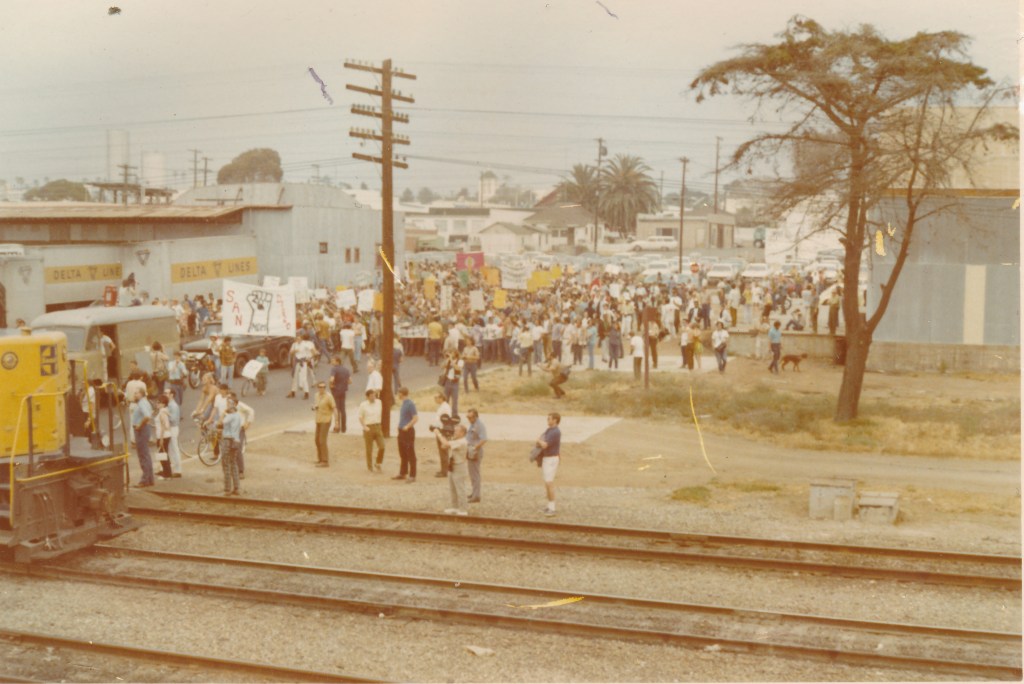
Just weeks later city leaders and downtown business owners would brace themselves for another “anti-war march and rally” expected to draw a crowd of 20,000. The city again denied a parade permit which the MDM appealed. U. S. District Court Judge Howard B. Turrentine temporarily upheld the city’s denial but set a hearing on the matter. Leaders of the protest said they would go forward with their planned demonstrations with or without a permit.
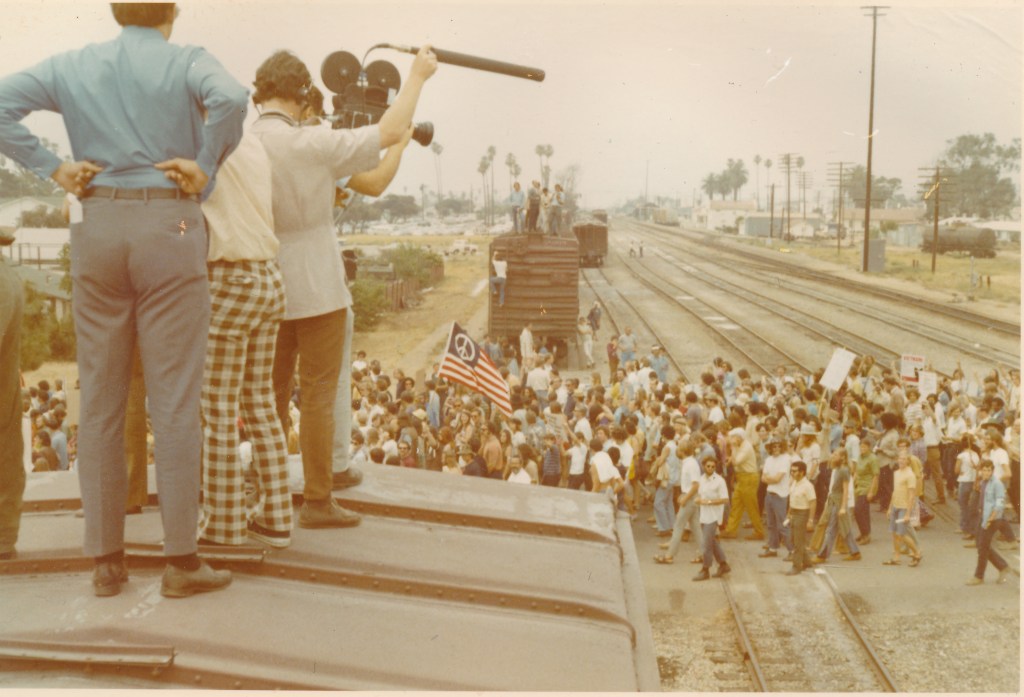
Governor Ronald Reagan’s office issued a statement saying that that “the governor will keep a close watch on the situation in Oceanside, since receiving a telegram Thursday from U. S. Senator Alan Cranston (D-Calif.) in which the senator declared the demonstration ‘Poses a serious threat of possible violence.’” Adding that “If mutual aid is requested, we are ready to supply whatever assistance is needed.”
Law enforcement both city and county met to assess the pending protest. It was reported that the National Guard would “be on an alert, if the situation should get out of control.”

Mayor Howard Richardson stated that, “Oceanside has no intention of providing demonstrators with reasons for violence. We shall do all within our power to assure the demonstration remains peaceful.”
An unidentified spokesperson for the MDM told the local newspaper that demonstrators would gather at the municipal parking lot at Third (Pier View Way) and Cleveland at 12:30 p.m. Saturday and that protestors would “march south to Tyson; west on Tyson to Pacific Street; South on Pacific to Wisconsin; West on Wisconsin to the Strand and north to the beach stadium.”
Tom Hurwitz stated that he was working with Oceanside police in an effort to keep the demonstration peaceful and added “we will have several hundred monitors to assist the police in controlling the march as it moves from the assembly area to the beach.”

On May 16, 1970 an organized march and protest was held but numbers were much lower than the 20,000 persons predicted. A reported 700 law enforcement officers and 200 monitors provided by the MDM watched as a crowd of 4,000 to 5,000 gathered on the streets of downtown Oceanside.
Kent Hudson declared the march a “tremendous success” and praised both the monitors and police for their handling of the situation. The march began with shouts of “Stop the War” and “Peace Now” as well as anti-Nixon, anti-war chants.
It was reported that some of the demonstrators lashed out at the military guards present, shouting obscenities, but the newspaper reported that they were, for the most part, “drowned out by anti-war chatter and hand-clapping by the protesters.”
Footage of 1970 protest from CBS 8 San Diego below:
As the march continued towards the beach, a Santa Fe freight train came into town, blocking the protesters from continuing on their route. After a disruption of ten minutes, the engineer was instructed to proceed south to San Diego without picking up his intended freight. Protesters then made their way south on Pacific Street to Wisconsin where they walked the Strand to the Beach Stadium.
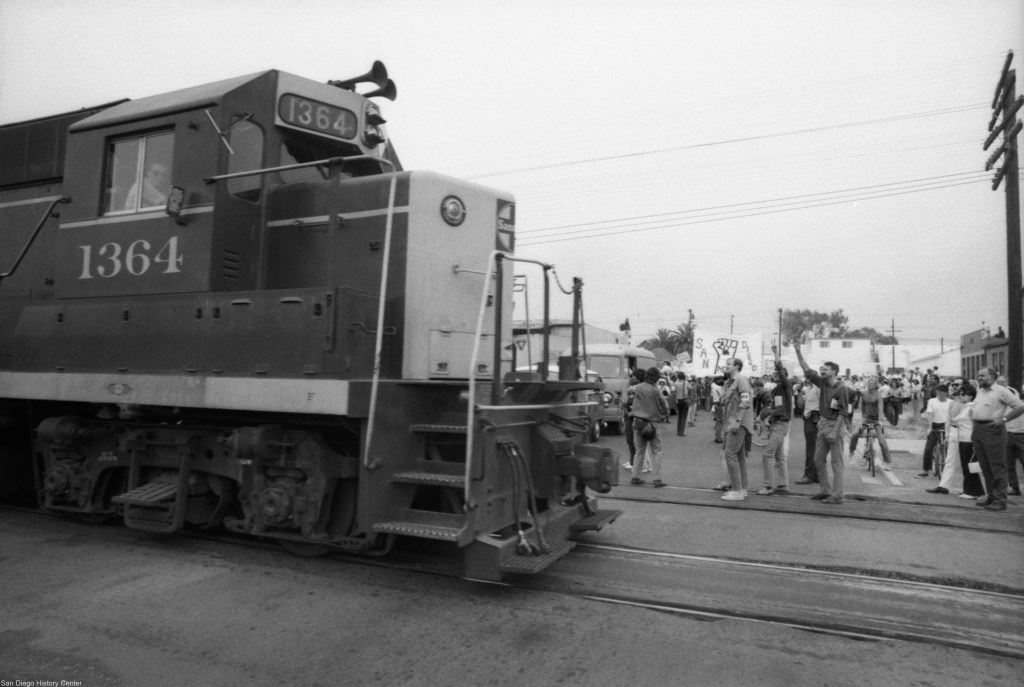
Tom Hayden, a founder of Students for a Democratic Society, who would later marry Jane Fonda, was the main speaker. There were a few clashes from counter protestors throughout a series of speeches but each were broken up by police.
It was noted that at the end of Hayden’s speech, several demonstrators raced from the stadium into Pacific Street when a small group of counter-demonstrators led by youths for American Freedom burned a Viet Cong flag” and that “during a brief melee between the counter demonstrators and MDM members, one protester was knocked to the ground.”

The Oceanside Blade Tribune reported that near the end of the event “all servicemen were asked to stand and show their Military identification cards. Of those who rose to comply at least one burned his card, waving it in the air. Then he swallowed the ashes.”
The newspaper concluded its report that “Many of those present at the demonstration reeked of marijuana. Others were stone-faced apparently bored by the whole affair or under the influence of drugs. But, the demonstration was peaceful. There were no injuries and no arrests.”
The following day an editorial ran in the conservative leaning Oceanside Blade Tribune entitled “We Wonder.”
The Blade-Tribune wonders what makes a person like most of the 5,000 or so who marched in the anti-war march in Oceanside Saturday.
We wonder how far the rights of this small-minority of rabble-rousers extend.
We wonder where are the rights of the people who make this country work, who pay the bills, and protect the nation.
We wonder why there are so many leftwingers, communist sympathizers and communists involved in the “peace” movement.
We wonder where the money comes from to support these people who don’t work, but work at undermining our nation.
We wonder why these people are allowed to flaunt the law, marching without parade permits.
We wonder why we, the taxpayers, must foot the bill for their parades. If they want to march, let them pay the bills.
We wonder why the Movement for a Democratic Military, our local radical group, and sponsor of the Saturday “anti-war” march, is so closely allied with the Black Panthers.
We wonder why so many of our teachers, who are shaping the minds of our children, are actively involved in supporting this movement.
We wonder why our school boards, boards of trustees, and other educational panels, haven’t got the guts to kick campus radicals off campus.
We wonder when the courts are going to get tough and stop bending over backwards to please these idiots.
We wonder if the news media as a whole isn’t encouraging these groups by poking television cameras and microphones and news cameras into their faces every time three of them get together and hold up a sign.
Finally, we wonder when it became unpopular to be a good American, to operate a profitable business, to serve the country, protect the nation.
We don’t think it is unpopular to do these things, but there are too many young radicals undermining this nation by degrading these principals.
Good Americans can only wonder what makes a protestor. We’re getting a pretty good idea.

In the summer of 1970, cracks in the unity of the various groups began to show. In July of 1970 Pat Sumi left for North Korea with a group which included exiled Black Panther Leader Eldridge Cleaver. A spokesperson for the MDM said that Sumi’s trip was “financed by several liberal groups located in Southern California.” The group were guests of the Committee for Reunification of Korea.
Just one year later, in 1971, Pat Sumi did an interview and was asked about the Movement for a Democratic Military and if it still existed. She gave a rather defeated reply: “Well, MDM still exists in the minds of people—but that’s not an organization, we discovered. We discovered what the Black Panthers have since discovered—that mass sympathy does not at all mean mass organization. Mass sympathy does not give you the power to change anything. We didn’t understand what an organization was.”
She then offered a different perspective about the group’s efforts and its impact saying, “We really messed up some G.I.’s. A lot of them went to jail. Some had to go AWOL. A few went to Canada. We had no way really to organize power to protect G.I.’s when they were arrested or harassed.”
Of the shooting of the MDM headquarters at 519 South Freeman Street she said: “Finally, the thing that really broke us was in April of 1970, last year. Someone fired 12 rounds into the MDM house and nearly killed a G.I. That was when we discovered we had no organizational way to respond. That was it. That was the crisis. That was when the pigs decided to confront us. That was when we discovered we had no real power.
“After that, it was downhill for the organization. I didn’t understand all this. Last summer, I was running around in Asia telling everyone about MDM when, in fact, it was really falling to pieces. I came home and there was no MDM left.”
In 1972 Oceanside Police Chief Ward Ratcliff, along with Police Sergeant John Key, attended a hearing for the “Investigation of Attempts to Subvert the United States Armed Services” held by the Committee of Internal Security, House of Representatives.
At the hearing the two were called to testify about their knowledge of the Movement for a Democratic Military and its activities in and around Oceanside, along with its principals and the celebrities that supported their cause. By that time the MDM aka the Green Machine, was no longer in Oceanside. Key testified that problems amongst the group surfaced in June of 1970. The Black Unity Party, established by Black Marines, eventually split from the MDM.
In her 1971 Pat Sumi discussed the difficulties amongst the various groups and reflected upon the outcome of the group’s seemingly failed mission:
“I discovered that in relating to international revolutionary movements, you have to represent something. For most of us, except for the Panthers—and even now for the Panthers, it is a question of who do they really represent—you shouldn’t get a bunch of individuals to go. It’s not useful. I suppose what it did do was to heighten my consciousness of the real critical need in the American movement for a party; some kind of guiding force that can take leadership in struggle.
“We don’t have it yet. Everyone is floundering around, trying to find direction on their own. I suspect this period of pre-party struggle will last a great deal longer; in fact, too long. I think we’re going to find that we’ll have to have a party, because a whole lot of us are going to wind up in jail. There’s a good possibility in the next two, three, four years that there’s going to be a massive repression. I don’t think it’ll kill a whole lot of us—but it will put a whole lot of us away.
“People are going to understand what we understood when the pigs decide to confront us, that if you don’t have the organizational power to meet that crisis, then comes the question—’Can you make it, can you make an organization? Will you have that power?'”
In July of 1971 the Oceanside Blade Tribune reported that the “Last Combat Marines” were returning from Vietnam. Members of Support Company, 7th Communications Battalion and Forces Logistics Command aboard the USS St. Louis would arrive Monday, July 19th at Pier “E” at the Long Beach Naval Station. U.S. Military involvement in the Vietnam War continued until 1973.

Today the little house on South Freeman Street still stands. Its cottage-like architecture belies its role as headquarters of a war protest movement, which for a brief time was the gathering place for young activists, counter-culture revolutionaries and celebrity sympathizers.


